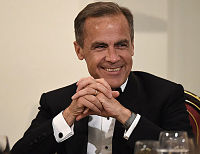The ‘age of irresponsibility is over’ says Bank of England head as he promises crackdown on rogue traders. (2015)

“Left unattended, (markets) are prone to instability, excess and abuse.
James Titcomb, The Telegraph, 10 June 2015
Bank of England Governor Mark Carney has declared that the “age of irresponsibility” in the City of London is over as the Bank promised a crackdown on rogue traders.
“Left unattended, (markets) are prone to instability, excess and abuse.
“Markets are … powerful means for prosperity and security for all. As such they need to retain the consent of society – a social licence – to be allowed to operate, innovate and grow.
“Repeated episodes of misconduct have called that social licence into question. We have all been let down by these developments. And we all share responsibility for fixing them.”
Read the full article here: The ‘age of irresponsibility is over’






Leave a comment (1)
Back to the topThis is a very intriguing perspective. I have no doubt that the Hubris syndrome is a real and prevalent phenomenon. In our research into the manifestations, root causes and defenses against existential strategic risk, i.e. those that will kill your company, the role of hubris, the character of the CEO and the effectiveness of the board are predominant themes.
However cognitive behavioural psychology suggests that although the board is the only mechanism for holding the balance between governance and the executive, and being capable of addressing strategic risk, it is in most cases impossible for boards and especially non-executives to be sufficiently aware of their own and others’ unavoidable cognitive biases.
The board should be a like a System 2 thought process, compared with the System 1 process represented by the executive, to use Nobel proze-winner Daniel Kahneman’s taxonomy (see “Thinking, Fast and Slow). However the individual board members System 2 (slow, focused, deliberate, effortful) thought processes and decisions are too readily displaced by their own System 1 (automatic, fast, intuitive, reflexive) decisions . The cognitive biases and illusions that lead to strategic risk from overconfident, optimistic, confirmation biased CEOs are replicated in the individual board members. Moreover evidence shows that such biases and illusions cannot readily be overcome. This is because, as Kahneman writes, “Biases cannot easily be avoided because System 2 (thinking) may have no clue to the error”. This is as true for individual board members, who may unaware of their own biases, as it is for boards in relation to executives – boards may be blissfully unaware of the risks being run.
Kahneman concludes that the best that can be done is to learn to recognise when mistakes are likely and try to avoid significant mistakes when the stakes are high. Unfortunately the circumstances for boards represent the worst combination for making strategic mistakes most likely, that is when boards are reviewing strategy, as presented by the executive.
Our conclusion is that boards need external help to be able to recognise the potential for System 1 thinking biases and illusions to lead to significant mistakes when the stakes are highest and adopt or fail to anticipate existential threats. We call these processes Strategic Risk Governance.
Supplied via LinkedIn by Neil Britten,
Partner at Britten Coyne Partners